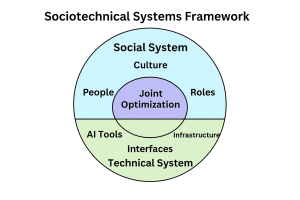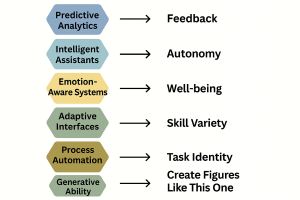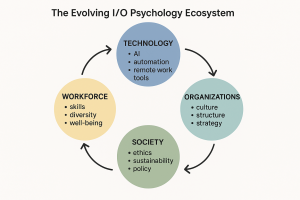9-3: Applications & Future Directions
Applications to Workplace Solutions
Human factors and AI considerations are increasingly vital for addressing traditional workplace challenges:
Absenteeism Solutions
Absenteeism Solutions can benefit from understanding cognitive workload and stress factors. Human factors principles can inform job redesign to reduce burnout, a common cause of absenteeism. AI can analyze attendance patterns to identify potential issues early, but human judgment is crucial for addressing root causes.
Technology-Enhanced Workforce Management

Technology-Enhanced Workforce Management uses AI to optimize scheduling, task allocation, and performance monitoring. However, human factors ensures these systems are implemented in ways that respect employee autonomy, reduce surveillance-related stress, and provide meaningful feedback rather than just raw data. This involves applying principles from work design theories, such as the Job Characteristics Model, to ensure redesigned roles offer sufficient autonomy, skill variety, task identity, task significance, and feedback, even when augmented by AI.

The sociotechnical systems theory is particularly relevant here, advocating for joint optimization of both the social (human) and technical (AI) aspects of a work system to achieve overall effectiveness. For example, AI-driven insights into workflow efficiency should be presented in a human-understandable format that empowers employees and managers, rather than simply dictating actions. AI is also being used in Human Resources teams to screen candidates, enhance onboarding, manage performance, and hire new employees.
Contemporary Challenges and Future Directions
The field of human factors, ergonomics, and AI in the workplace faces several evolving challenges:
Rapid Technological Change
Rapid Technological Change means keeping pace with new AI developments and their implications for work design. What’s cutting-edge today might be obsolete tomorrow.
Ethical AI Governance
Ethical AI Governance involves developing robust frameworks for ethical AI development, deployment, and oversight. How do we ensure AI serves humanity rather than the other way around?
Reskilling and Upskilling
Reskilling and Upskilling addresses the massive training needs arising from AI-driven job transformations. Workers need to continuously learn new skills to stay relevant.
Measuring Human-AI Team Performance
Measuring Human-AI Team Performance requires developing new metrics to evaluate the effectiveness of collaborative human-AI systems. Traditional performance measures may not capture the full picture.
Maintaining Human Agency
Maintaining Human Agency ensures that AI augments human capabilities rather than diminishing human control and decision-making. Humans should remain in the driver’s seat.
Addressing Algorithmic Bias
Addressing Algorithmic Bias involves continuously working to identify and mitigate biases in AI systems that could lead to unfair outcomes.
Psychological Safety in AI Environments
Psychological Safety in AI Environments means creating environments where employees feel safe to experiment with AI, provide feedback, and voice concerns without fear of reprisal.
Organizational Readiness
Organizational Readiness presents a significant challenge, as many organizations lack the strategic plans and processes to manage and capitalize on AI’s vast capabilities. Recent research suggests that a substantial portion of companies either don’t plan to use AI or haven’t yet leveraged the technology, highlighting a gap between AI’s potential and organizational preparedness.
Emerging Innovations in Human-AI Collaboration
As AI becomes more integrated into the workplace, new innovations are emerging that enhance how humans and AI systems interact. These technologies aim to improve usability, build trust, and support employee well-being.
Explainable AI (XAI)
Explainable AI (XAI) refers to systems designed to make their decision-making processes transparent and understandable to human users. Rather than operating as a “black box,” XAI provides insights into how and why a particular decision was made. This transparency builds trust, supports accountability, and enables users to validate or challenge AI outputs. However, implementing XAI requires balancing clarity with technical complexity, and ensuring explanations are meaningful to non-experts.
Emotion-Aware Systems
Emotion-aware AI systems use sensors, facial recognition, voice analysis, or text sentiment analysis to detect users’ emotional states. These systems can adapt responses based on user mood, offering empathetic support or adjusting task difficulty. In customer service, for example, emotion-aware bots can de-escalate tense interactions. In internal tools, they can help identify burnout or disengagement. Challenges include ensuring privacy, avoiding misinterpretation of emotions, and maintaining ethical boundaries in emotional data use.

Adaptive Interfaces
Adaptive interfaces dynamically adjust based on user behavior, preferences, and performance. For example, a dashboard might simplify its layout for a novice user or highlight advanced features for an expert. These interfaces enhance usability, reduce cognitive load, and personalize the user experience. Implementation challenges include designing for diverse user needs, avoiding over-adaptation that reduces user control, and ensuring accessibility across devices and abilities.
Future Directions and Implications

Emerging Organizational Forms
The integration of AI into workplace design will likely lead to new organizational forms that emphasize flexibility, adaptability, and human-AI collaboration. Organizations will need to develop new structures and processes that can effectively leverage both human and AI capabilities.
Workforce Evolution
The nature of work itself is evolving as AI takes over routine tasks and humans focus on more creative, strategic, and interpersonal activities. This shift requires new approaches to job design, skill development, and career planning.
Sustainable AI Implementation
Future AI implementations must consider long-term sustainability, including environmental impacts, social equity, and economic viability. This requires a holistic approach that considers the full lifecycle of AI systems and their effects on society.
Human-Centric Innovation
The most successful AI implementations will be those that prioritize human well-being and empowerment rather than simply optimizing efficiency. This human-centric approach will become increasingly important as AI capabilities continue to expand.
Conclusion
This module highlights the critical intersection of human psychology, technological design, and artificial intelligence in shaping the modern workplace. By applying human factors and ergonomic principles, organizations can design work systems that not only enhance efficiency and productivity but also safeguard employee well-being and foster effective human-AI collaboration.
As AI continues to evolve, the principles discussed in this module will become even more indispensable for creating humane, effective, and future-ready work environments. The emphasis on human-centered AI implementation ensures that technological advancements serve human flourishing, rather than merely optimizing tasks.
Why does this matter for you? Because whether you’re planning to be a psychologist, manager, entrepreneur, or employee, you’re going to be working in a world where AI is ubiquitous. Understanding how to design work that leverages AI while maintaining human dignity, creativity, and well-being isn’t just academic knowledge — it’s survival skills for the modern workplace.
Media Attributions
- Sociotechnical Systems Framework
- Man Exercising His Arm Muscles © Unknown is licensed under a CC BY (Attribution) license
- AI Enhanced Work Design Principles © Jay Brown and Copilot
- The Evolving I/O Psychology Ecosystem © Jay Brown and Copilot
